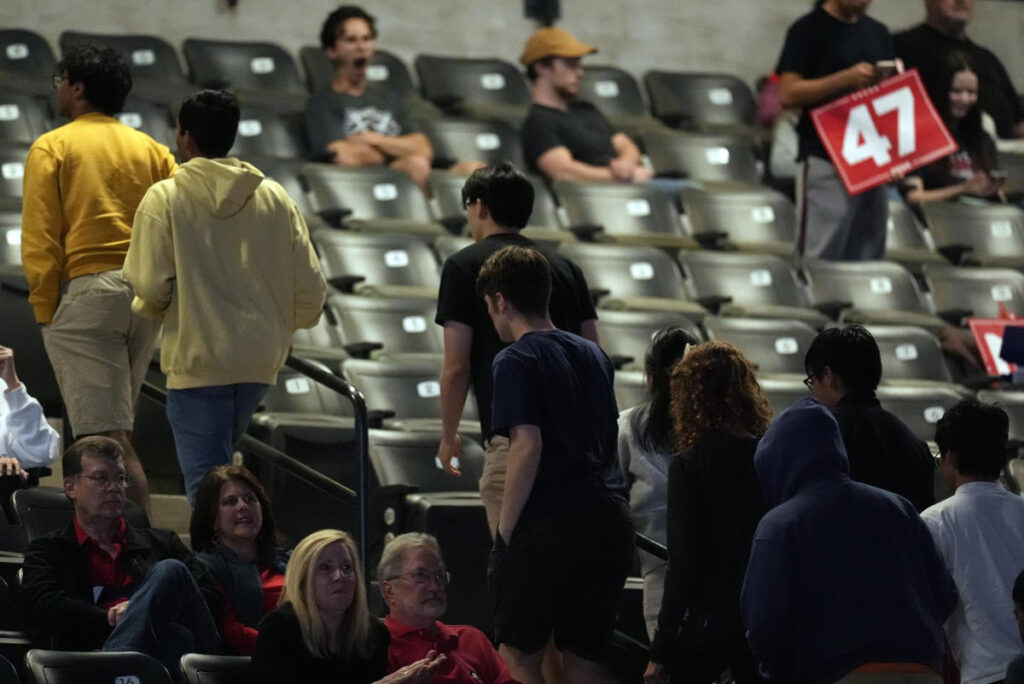Donald Trump has been known for boasting about the size of his rally crowds during his nearly decade-long political career. However, in his current presidential campaign, he faces a competitor, Kamala Harris, who also attracts large crowds, highlighting the contrast between their respective events. During a recent rally in Greensboro, North Carolina, the capacity of the First Horizon Coliseum of 22,000 saw significant unfilled seats in the lower level, while the upper level was entirely blocked off. Despite this, Trump confidently asserted that he consistently draws full crowds, a claim contradicted by the visible empty seats at various venues over the campaign trail, including Reading, Pennsylvania, and Pittsburgh. Although crowds at Trump’s engagements can still number in the thousands and showcase enthusiastic supporters, the overall attendance and energy differ from the turnout during his first presidential campaign.
As the closing days of the campaign unfolded, observations indicated that Trump’s latest rally audiences were smaller than in previous elections. His lengthy speeches sometimes led to dwindling numbers as attendees left during the events. The phenomenon might be attributed to several factors, including campaign fatigue and repetitiveness in location—Trump frequently returns to the same critical battleground states, sometimes revisiting the same cities and venues. For example, his recent Greensboro rally was just eight days after he had campaigned there. Additionally, the former president’s habitual lateness—an event starting as much as three hours behind schedule—might also contribute to audience attrition.
Despite these empty seats, Trump’s rallies in 2023 still managed to engage large groups of dedicated supporters, as evidenced by a crowded event in Grand Rapids, Michigan, where attendees lined up for hours. However, the departure of audience members during his speeches provides a notable contrast to his past performances. In 2016, Trump’s events were characterized by high energy and long-lasting audience engagement, while this election season sees some members leaving even after enduring a lengthy wait for entry. This shift begs the question of whether Trump’s captivating influence is waning with repeat visits to popular campaign stops.
Critics and political opponents have seized upon Trump’s struggles with crowd sizes to underscore the shifting dynamics of this presidential race. Notably, Democratic figures like Barack Obama and Kamala Harris have capitalized on the notion of crowd size to frame Trump as increasingly out-of-touch. Obama playfully referenced Trump’s “weird obsession” with attendance numbers during a Democratic National Convention speech, while Harris emphasized attendance during her debate with Trump, suggesting that supporting his rallies could signal the end of his political era.
This election season has seen Harris effectively mirror Trump’s rally strategy, filling attendees with a similar sense of excitement across various venues. The presence of celebrities like Beyoncé and Oprah Winfrey at her events amplified the star power surrounding her campaign, contrasting with the more singular focus of Trump’s rallies, which continue to center on him personally. In Pittsburgh, Trump remarked on the one remaining rally of his campaign, exhibiting a degree of nostalgia for his once-legendary gatherings, alluding to their uniqueness and excitement as an unparalleled experience.
As the election draws near, it becomes increasingly evident that crowd size dynamics, while not definitive predictors of electoral outcomes, highlight significant contrasts in campaign engagement between Trump and Harris. Trump’s nostalgic reflections on the rally ambiance, coupled with the visible shifts in audience attendance, suggest a possible decline in his once-dominant rally charisma. The stakes of this political season intensify as both campaigns vie for voter enthusiasm, bridging the gap between energetic appearances and the practicalities of electoral success. As Trump embarks on his final push for the presidency, the presence or absence of crowds could crucially affect his narrative, ultimately illustrating the evolving landscape of American political rallies.

